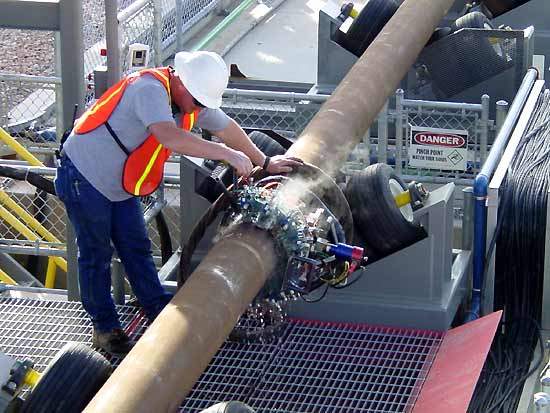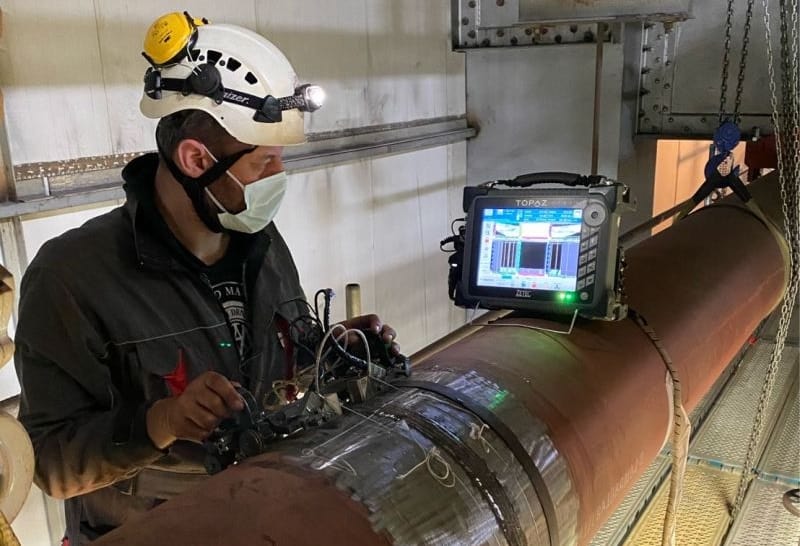Quality Assurance Guaranteed: Expert Pipeline Welding Inspection Solutions
Maximizing Performance: Pipeline Welding Inspection Ideal Practices
In the world of pipeline building and construction, the stability and security of bonded joints are critical. Ensuring that welding examinations are carried out successfully and successfully can considerably influence the general top quality of the job. By applying finest techniques for pipeline welding examination, organizations can simplify processes, decrease errors, and boost project timelines. From making use of advanced technology to establishing rigorous evaluation methods, there are numerous methods that can be used to take full advantage of effectiveness in this important facet of pipeline building - Pipeline Welding Inspection. The meticulous interest to information called for in welding evaluation holds the crucial to the lasting sturdiness and integrity of the pipes, making it a subject of utmost significance in the sector.

Significance of Reliable Welding Inspections
Efficient welding assessments play a critical role in making certain the structural honesty and safety of pipelines. Appropriate examinations are vital to identify any issues, stoppages, or blemishes in the bonded joints that can compromise the total integrity of the pipeline system. By conducting comprehensive examinations, examiners can discover issues at an early stage, protecting against potential leakages, ruptures, or failings that might have significant environmental and safety and security effects.
Precise and prompt welding evaluations also assist in keeping compliance with sector standards and regulations. Sticking to these requirements is not only a legal need yet additionally a needed measure to ensure the integrity and long life of the pipes. Effective evaluations can add to cost savings by decreasing the demand for expensive repair services or substitutes due to welding issues that might have been stopped or dealt with during the evaluation process.
Utilizing Modern Technology for Examinations
To enhance the effectiveness and precision of pipeline welding assessments, the integration of sophisticated technologies has actually come to be progressively imperative in making certain precise and detailed analyses of welded joints. Utilizing technology for inspections supplies countless benefits, consisting of increased effectiveness, enhanced accuracy, and improved precaution. Among the essential technological improvements in pipeline welding assessments is using automated ultrasonic testing (AUT) systems. These systems can check welds promptly and accurately, giving detailed information on prospective defects or problems within the weld joint. Furthermore, remote visual evaluation (RVI) devices such as robotic crawlers outfitted with video cameras enable assessors to accessibility and assess difficult-to-reach areas without the requirement for considerable disassembly or hand-operated treatment. The implementation of computerized systems for information evaluation and reporting enhances the inspection process, enabling real-time information interpretation and seamless documentation. By accepting these technological options, pipe welding evaluations can be carried out much more efficiently, leading to better welds, boosted overall security, and lowered task timelines.
Establishing Clear Evaluation Protocols
Establishing clear assessment procedures is vital for making certain consistency and dependability in the pipeline welding examination process. These methods function as a set of standards that outline the details actions, criteria, and methods to be complied with throughout evaluations. By clearly specifying the evaluation methods, all assessors associated with the procedure can comprehend their duties and functions, resulting in a more efficient and standard examination workflow.

Routine testimonial and updates to the assessment protocols are also critical to adapt to transforming sector requirements and requirements. By continually refining and boosting the procedures based on comments and lessons found out, pipe welding examinations can support the best quality standards and regulative conformity.
Training and Accreditations for Assessors
Educating and qualifications for examiners are vital in ensuring the capability and proficiency of people tasked with managing pipeline welding procedures - Pipeline Welding Inspection. Correctly trained assessors have the essential knowledge and abilities to successfully examine weld top quality, adherence to welding procedures, and conformity with sector standards and laws
Qualifications, such as those provided by the American Welding Society (AWS) or the American Petroleum Institute (API), confirm an examiner's expertise and capability to execute examinations to the highest possible criteria. These accreditations commonly require extensive training, evaluations, and continuous expert growth to make certain that examiners remain existing with the latest improvements in welding modern technology and evaluation techniques.
Along with official website formal accreditations, continual training programs play an essential duty in enhancing assessors' abilities. These programs cover a vast array of subjects, including welding processes, issue discovery, safety and security protocols, and appropriate codes and requirements (Pipeline Welding Inspection). By spending in extensive training and certifications for assessors, companies can maintain the stability of their pipe welding tasks and mitigate the threats connected with ineffective welds
Continual Renovation in Evaluation Processes
Building upon the foundation of qualified and trained examiners, continual improvement in examination procedures is important for making certain the continuous quality and conformity of pipeline welding operations. By implementing a system of constant enhancement, pipe welding examination processes can develop to meet the altering demands of the industry, technical innovations, and regulative needs. This entails frequently examining and reviewing examination tools, methods, and treatments to determine locations for improvement.
One trick facet of continuous improvement in examination procedures is comments. Gathering input from examiners, welders, engineers, and other stakeholders permits a detailed assessment of present techniques and the recognition of possible locations for renovation. In addition, leveraging analytics and information can provide beneficial insights into the performance of inspection processes, making it possible for educated decision-making for optimization.
Moreover, investing in training and growth programs for assessors can ensure that they are outfitted with the most recent expertise and skills to do their duties efficiently. Continual improvement is a dynamic process that needs commitment and commitment from all stakeholders to drive excellence in pipe welding assessment practices.
Conclusion
To conclude, taking full advantage of effectiveness in pipeline welding evaluations is important for guaranteeing the high quality and security of infrastructure tasks. By making use of modern technology, developing clear protocols, giving appropriate training and certifications for assessors, and continually improving inspection processes, companies can enhance their procedures and decrease dangers. It is best site imperative for industries to focus on effective welding assessments to keep high standards and fulfill governing requirements.
Reliable assessments can contribute to set you back financial savings by lessening the requirement for expensive repairs or replacements due to welding defects that might have been prevented or dealt with during the inspection process.
Developing clear inspection protocols is important for ensuring uniformity and integrity in the pipe welding evaluation procedure. By plainly specifying the inspection procedures, all examiners involved in the process can comprehend their functions and responsibilities, leading to an extra efficient and standardized evaluation process.
Clear examination protocols help in minimizing the probability of errors or oversights throughout the assessment procedure.Structure upon the structure of experienced and qualified assessors, continual enhancement in evaluation procedures is vital for guaranteeing the recurring top quality and compliance of company website pipeline welding procedures.